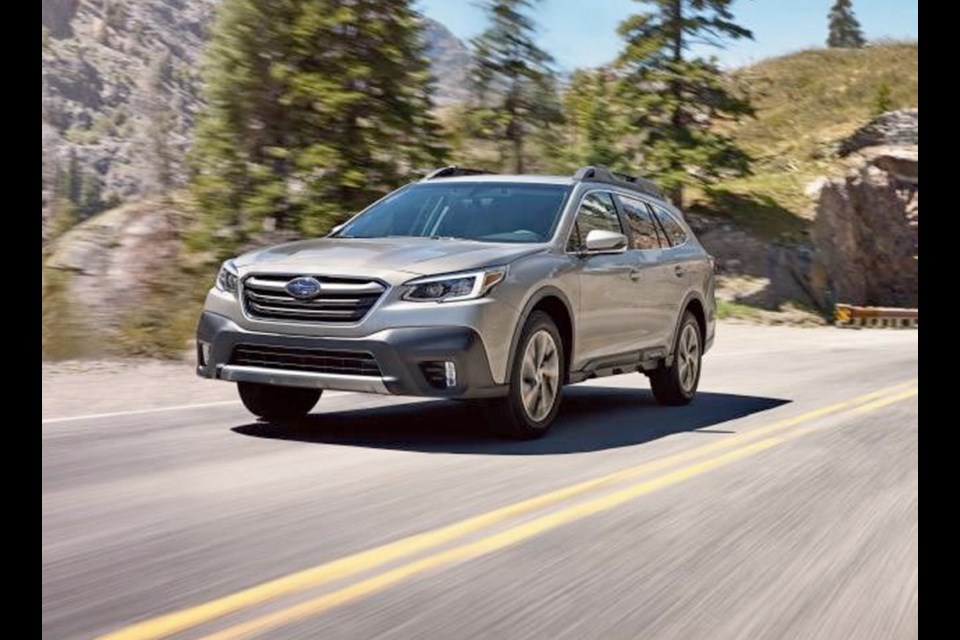You could be forgiven if you missed the new and improved 2020 Subaru Outback parked next to your old Outback.
In fact, Subaru will be happy to hear that, given that its target market is customers who don’t like much change.
In a world bombarded by more and more SUVs, the station wagon (manufacturers cringe when they hear that phrase, opting to call their vehicles wagons or crossovers) bodystyle is all but extinct.
Except, of course, the 2020 Outback.
This is the sixth generation of the Outback, a model created in 1995 to tap into an unexpectedly strong consumer demand — and few competitors.
Then, as now, consumers were looking for a vehicle with passenger-car comfort and the ability for rugged off-road adventures.
The early Outback was simply a Legacy station wagon with higher ground clearance and styling cues, such as large fog lights and contrasting plastic cladding on the lower body.
The success of the Outback inspired a smaller version, the Outback Sport, based in the Impreza platform. The Outback Sport model was discontinued, but its successor is the current Crosstrek.
There are seven trim models of the 2020 Outback to choose from, starting at $30,695 for the Convenience model. I drove the top-of-the-line Premier XT, with a list price of $43,795.
While the exterior is relatively the same, the biggest change is under the hood. You have a choice of two engines, with the base unit sporting a 2.5-litre four with direct injection producing 182 horsepower and 176 pound-feet of torque.
The top three models, the Outdoor, Limited and Premier, have a turbocharged 2.4-litre, pumping out a healthy 260 hp and 277 lb.-ft. of torque.
Truth be told, the more powerful engine doesn’t feel that way under acceleration in town. You have to open it up on the highway to feel the extra oomph. The sweet spot is the engine’s midrange, where it delivers its power to either merge with traffic, or to pass that 18-wheeler on a hill.
The only transmission is a CVT with paddle shifters and eight virtual gears.
The turbo engine is more powerful than the six-cylinder it replaces - and is more fuel-efficient, with included engine stop/start in the city. As an added bonus, the engine is engineered to run on regular, not premium gasoline.
It would be of interest to people who like to tow, as the turbo Outback’s hauling capacity increases from 1,225 to 1,590 kilograms.
The 2020’s ride has improved as well. The 2020 Outback is now built on Subaru’s new Global Platform. They claim that the new chassis is stiffer and able to absorb 40 per cent more energy in case of a collision.
On the road, the Outback is very composed and quiet. While far from a performance car, it handles corners well, with a well-damped suspension soaking up the road imperfections.
All Outbacks are all-wheel drive, with what Subaru calls X-Mode, a set of programming algorithms that is supposed to get you home even after the most gnarly off-road surfaces.
You get 220 millimetres of ground clearance (8.7 inches) and agility that would make a mountain goat jealous.
The Outback is classified as a mid-size, which means you benefit from generous passenger space and cargo volume. It will easily carry five and all the trappings for an off-road adventure. With the seats up, the back will hold 920 litres, and swallow 2,144 with the back seats folded.
For those who like to sleep in the back, the floor length is a comfortable 1,906 mm (six feet, three inches) long. Standard roof racks allow you to easily carry items on the roof.
The new interior is decidedly more upscale, more inviting and cutting-edge. The tester I was driving featured supple Nappa leather seating (heated and ventilated for the front occupants) and impressive fit and finish.
The centre console has been taken over by a single 11.6-inch, vertically oriented infotainment screen (like a large tablet) with touch controls for the most part (there are still physical knobs for the audio system’s volume and tuner, and up and down buttons for temperature selection for the climate control).
The screen is very user-friendly, but some of the lesser-used vehicle controls are buried under menus and sub-menus.
My tester came with Subaru’s EyeSight safety suite (the name was coined because it mimics humans by using two cameras to better judge depth). The suite includes pre-collision braking, pre-collision throttle management, adaptive cruise control, lane-centring assist (new for 2020), lane-departure warning, lane-sway warning and lane-keep assist.
New this year in the Premier trim is Subaru’s DriverFocus driver monitoring system. This system uses a camera angled at the driver’s face and facial recognition software to monitor fatigue or lack of attention.
If the system detects the driver losing focus, the system sends out a alert. The system can store preferences for up to five drivers, including the position of the seats, side mirrors, climate control settings and gauge readouts on the multi-function display.
My favourite piece of technology is the reverse automatic braking system. It will apply the brakes automatically if it detects an obstacle and determines that a collision is imminent.
The 2020 Outback might be more powerful, bristling with cutting-edge technology that make it more frugal and safer, but it looks pretty much the same as before. That’s just fine with its loyal fans.
THE SPEC SHEET
Type: Mid-sized four-door wagon, front engine, all-wheel-drive
Engine: Turbocharged 2.4-litre four-cylinder, 260 hp at 5,600 r.p.m., 277 lb.-ft. of torque at 2,000 to 4,800 r.p.m.
Transmission: CVT
Dimensions (mm): Length, 4,860 ; width (mirrors folded), 1,897; height (with roof rack), 1,687; wheelbase, 2,745
Curb weight (kg): 1,786
Price (base/as tested): $43,795/ $45,695 (includes $1,800 freight and PDI and $100 AC tax)
Options: Nil
Tires: 225/60 R18 on alloy wheels
Fuel type: Regular
Fuel economy (L/100km): 10.1 city/ 7.9 highway
Warranty: Three years/60,000 km new car, five years/100,000 km major components



